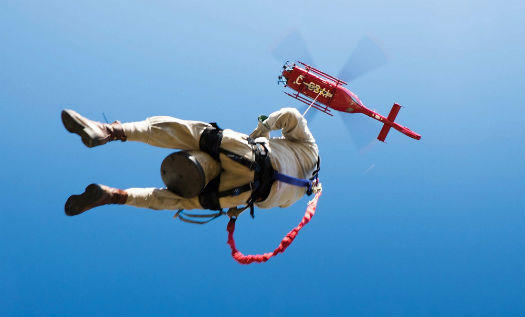
Blackcomb Aviation is one of the Canadian helicopter operators currently performing Class D human external cargo operations in the power utility industry. The company uses a twin-engine Airbus Helicopters H135 (EC135) for the work. Marc Witolla Photo
On the afternoon of Saturday, Feb. 28, 2015, Talon Helicopters chief pilot Kelsey Wheeler was at the hockey rink with his seven-year-old when a rescue call came in. A hiker had fallen approximately 30 feet on Crown Mountain, a popular outdoor recreational area north of Vancouver, B.C. Wheeler responded in Talon’s Airbus Helicopters AS355 TwinStar helicopter along with members of the North Shore Rescue Team, who hover-exited at the scene. Once the hiker (who had badly injured his arm) had been stabilized, Wheeler long-lined him and a rescuer to safety using a human external transport system (HETS), then returned to retrieve the rest of the rescue team.
The following day, Wheeler was again called to perform a HETS rescue on Crown Mountain, this time for a 67-year-old man who had injured his leg. And on the very next day, Talon Helicopters pilot Jarrett Lunn performed yet another HETS rescue on Crown Mountain, extracting two climbers who had been stranded overnight and suffered mild hypothermia.
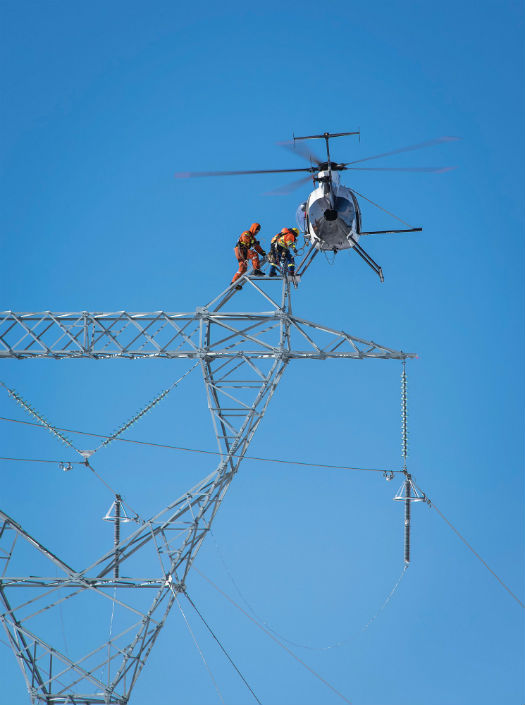
Hover entries and exits, and “touch-and-go” landings, are widely used work methods in the power utility sector. In some cases, HEC can be a desirable alternative that provides pilots with more “wiggle room.” Shawn Evans Photo
Three HETS rescues in three days is notable, but not unheard of. “It comes in fits and spurts,” Wheeler said, recalling that when he hired on with Vancouver-based Talon, it was with the expectation that he would eventually be doing search-and-rescue (SAR) work, including HETS rescues in the rugged mountains of coastal British Columbia. After a certain point, he said, “you realize it’s not if you’ll do [HETS], it’s when.”
Human external cargo [HEC] — the transport of a person or persons at the end of a helicopter’s long line — has become an invaluable tool for mountain rescues since the concept was first introduced to Canada in the 1970s. As the Talon example shows, the approach remains as relevant as ever, allowing rescue teams to rapidly access and evacuate people in trouble. “In some of these remote mountainous locations, [HETS] is the best way to do it,” said Talon Helicopters president and owner Peter Murray. “[With] vertical reference, we can bop in and bop out faster than we can with a hoist.”
In recent years, HEC has been seeing wider application in Canada as a work method in the power utility sector, where it is being used for such tasks as transferring linemen onto transmission towers. This is similar to the trend in the U.S. power utility sector, which has also witnessed growing use of HEC for routine maintenance and powerline construction (see p.36, Vertical, Oct-Nov 2014). Yet while the U.S. Federal Aviation Administration (FAA) has afforded wide latitude to power utility helicopter companies in their HEC operations, in Canada, HEC is subject to stricter regulations and oversight. That is shaping a different, more conservative approach to HEC north of the border, even as Canadian helicopter operators and their customers come to more fully appreciate the advantages the method has to offer.

Canadian Aviation Regulations stipulate minimum requirements for pilots involved in Class D HEC rescue operations. However, many rescue pilots in Canada far exceed those minimums — and also have a knack for staying calm under pressure. Ian Wills Photo
A Life-Saving Tool
Helicopter HEC as a rescue tool dates back to the 1960s, when the method was pioneered in Europe. It came to Canada during the following decade, thanks in large part to the efforts of renowned mountain-flying pilot Jim Davies. A Banff, Alta., native who was at the time employed by Bow Helicopters, Davies worked with wardens at Banff National Park to develop a sling-rescue program in the early 1970s, later playing a key role in refining and standardizing HEC techniques and equipment.
Today, HEC remains a key component of Parks Canada’s rescue program in Banff and beyond. Since 1994, one important service provider has been Alpine Helicopters, which conducts HEC and other rescues in conjunction with the Parks Canada Visitor Safety Program, Kananaskis Country Public Safety, and Emergency Management B.C. Alpine keeps a Bell 407 and qualified rescue pilot on standby 365 days a year at its base in Canmore, Alta., and offers similar availability from its base in Golden, B.C. Moreover, according to Alpine Helicopters training and check pilot Paul Maloney, “We are often able to rally up another 407 and pilot when multiple incidents are occurring simultaneously, which can sometimes be the case during the summer months.”
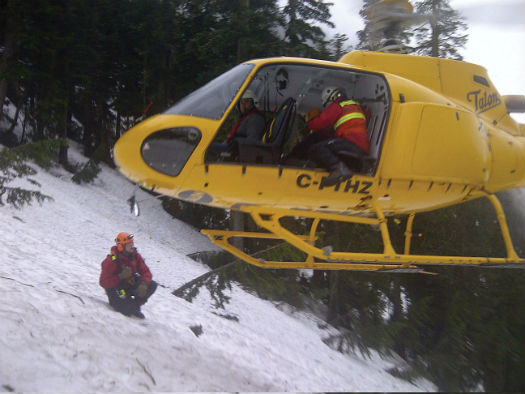
Talon Helicopters has been conducting HETS rescues in British Columbia since the late 1990s. However, the company’s pilots use the technique wisely; they will land, or perform hover exits and entries, when circumstances permit. Talon Helicopters Photo
As is common in Canada, Alpine’s service is based on longstanding relationships with its partner agencies, rather than formal contracts. “It’s basically a gentlemen’s agreement,” explained Maloney. “This is just a service the company has decided to provide for the mountain community.”
Maloney estimated that Alpine performs upwards of 200 rescues per year, about 40 percent of which are HETS rescues. While many of these are technical mountain rescues, rugged terrain isn’t the only place where HETS can be the rescue method of choice; during Alberta’s catastrophic flooding in 2013, Alpine used HETS to sling numerous flood victims to safety. “[HETS] is a valuable technique because it’s quite simple from a systems standpoint,” Maloney said. “You can go with a very small team and get a very big result with it. . . . You can have someone out of their predicament and to advanced medical care very efficiently.”
Yet Alpine and its partner agencies are also keenly aware of the risk inherent in having a person dangling at the end of a long line. Part of the company’s approach to managing that risk involves pilot selection and training — Alpine’s rescue pilots are all very high-time, and must demonstrate the necessary aptitude and attitude before they’re entrusted with human cargo. Once qualified, pilots train regularly with rescue personnel to keep their skills and coordination sharp.

Here, an example of how Class D HEC can keep the helicopter well clear of the wire environment during certain power utility operations. In each operation, however, the advantages of HEC must be carefully weighed against its inherent risks. Duncan Wassick Photo
The other part of Alpine’s risk management involves knowing when to use the HETS technique, and when not to. “You have to use it wisely and responsibly, while always looking for other alternatives,” Maloney said, explaining that even when HETS is the best choice for a rescue, the staging area should be set up as close as possible to the scene of the rescue to minimize time on the line. “That’s our mantra, just minimizing our exposure, because we do it so much.”
Highly capable pilots, regular training, and a focus on minimizing exposure are common attributes of HEC rescue programs in Canada — and they’re also requirements grounded in the Canadian Aviation Regulations (CARs). Humans are classified as helicopter Class D external loads under CAR 702.21, and their carriage is subject to higher standards for aircraft, equipment, and pilot training. Generally speaking, Class D operations require multi-engine helicopters with one-engine inoperative (OEI) hover performance at the operating weight and altitude, but Canada’s Commercial Air Service Standard 722.21 provides an exemption to this requirement for rescue, law enforcement, and firefighting operations. That exception, however, is based on the assumption that exposure will be minimized: only “flight crew members and persons essential during flight” can be carried, and they must be transported externally “only to the nearest suitable landing site.”
Is this exemption appropriate? As the Transportation Safety Board of Canada has recently noted, “the risks associated with a power loss while conducting HETS are greatly reduced by the use of multi-engine helicopters.” According to Talon’s Peter Murray, however, intermediate helicopters like the single-engine AStar and twin-engine (but OEI-performance-limited) TwinStar are often a better choice for mountain rescue than larger multi-engine aircraft.
“The intermediate helicopter is far superior for mountain SAR due to its size and nimbleness,” Murray said, noting that such helicopters are often able to land, or perform hover exits and entries, in locations where medium-category helicopters would be restricted to hoist operations. “You can give me a free medium for SAR,” he continued, “I wouldn’t take it. I’ll take my TwinStar/AStar every time.”

Alpine Helicopters currently has six qualified mountain rescue pilots on staff. “All the pilots involved probably have an average of 7,000-plus hours,” said Alpine training and check pilot Paul Maloney. “In addition to good long-line and mountain skills, we look for those who will provide a high degree of safety, reliability, integrity and operational stability in challenging and sometimes stressful situations.” Alpine Helicopters Photo
Working the Line
The U.S. also has fairly strict requirements for Class D HEC operations, including the use of aircraft with OEI hover performance at the operating weight and altitude. However, the FAA interprets its regulations very differently than Transport Canada interprets the CARs.
U.S. regulations state that no person shall be carried during rotorcraft external load operations unless that person performs an essential function in connection with the external-load operation. But the FAA’s interpretation of “essential” personnel is quite accommodating — it includes rescue personnel for rescue operations, and linemen for power utility operations, allowing both to be carried as Class B (jettisonable) loads. As a jettisonable load can be almost anything, there are few restrictions on how such a load must be carried. Consequently, for many of the HEC operations currently being conducted in the U.S., the FAA has little or no say over the type of aircraft or equipment being used.
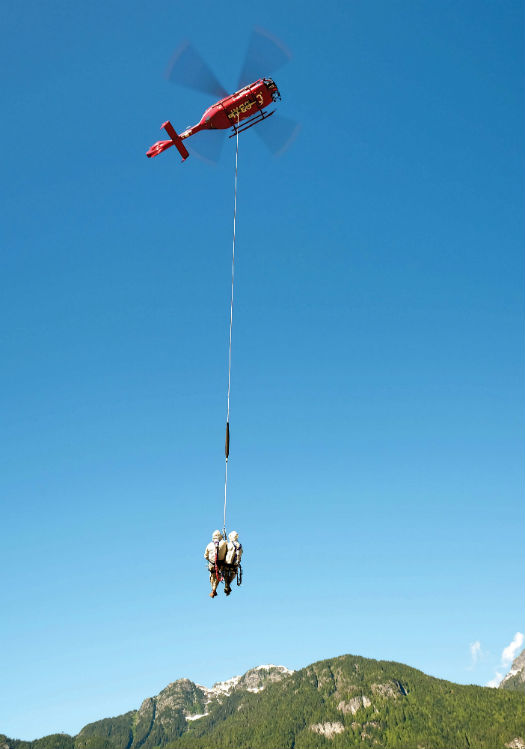
As the EC135 is certified for right-hand pilot-in-command operations, Blackcomb currently flies with two pilots: a nominal PIC in the right seat, and a vertical reference pilot in the left. The company is working with Transport Canada on left-hand PIC certification for the 135. Marc Witolla Photo
Not so in Canada, where any HEC operation that is not related to rescue, law enforcement, or firefighting is subject to the full force of Class D requirements. That means that, unlike in the U.S., you won’t see linemen being slung onto transmission towers using MD 500s. In Canada, companies that have moved into power utility operations have done so with twin-engine aircraft, Transport Canada-approved personnel carrying devices, and clearly defined operational procedures and employee qualification and training requirements.
One of the companies that has made the move into such operations is Blackcomb Aviation, which is now performing HEC work for the provincial Crown corporation B.C. Hydro. Blackcomb isn’t new to HEC; it has been using the technique for mountain rescues since 1991. In 2013, it received a Transport Canada exemption to the applicable Class D OEI requirements to use a TwinStar for power utility operations — for example, transferring linemen onto conductor carts and moving them around dead-end towers. When the exemption was not renewed, the company acquired an Airbus Helicopters EC135 (now H135) to continue the work.
“It’s becoming a very popular work method,” said Blackcomb Aviation vice president of operations Andrew Bradley, who identified time and cost savings as principal reasons for HEC’s popularity in the power utility sector. Slinging linemen to the top of a transmission structure can often be accomplished in a fraction of the time it would take linemen to access the tower via ground vehicles and climbing. “You very quickly realize there’s a ton of efficiencies,” Bradley said.
There’s also a safety argument to be made for HEC. For example, in British Columbia, linemen are often moved onto towers with flat bridges using “touch-and-go” landings, which is “a bit of a risky operation,” said Andrew Simpson, manager of aircraft operations for B.C. Hydro. “The idea with the Class D HETS is it allows a little more wiggle room for the pilots.” HEC also provides a way of rescuing injured or incapacitated linemen in remote locations, which was B.C. Hydro’s original motivation for adopting the technique.
However, B.C. Hydro — which undertook a thorough review of its helicopter operations following a fatal accident in Cranbrook, B.C., in May 2008 — has been extremely cautious in its approach to HEC. Currently, only a handful of operators have the necessary memoranda of understanding with B.C. Hydro for HEC operations, including Blackcomb, Canadian Helicopters, and Ascent Helicopters (which also conducts hoist operations for the corporation, primarily using a Bell 212HP). According to Simpson, B.C. Hydro places a premium on pilot experience and training, preferring to see pilots with at least 4,000 hours of flight time, and significant experience in wire and mountain environments.
That’s in addition to the regulatory requirements, which include Transport Canada approval of the personnel carrying device to be used. That particular requirement has caused some headaches over the years for both rescue and power utility operators. On the rescue side, the standard personnel carrying equipment has long been the HETS product from Vancouver, B.C.-based Emergco, which was first certified in the late 1990s. When new aeronautical manufacturing regulations came into effect in 2008, however, Emergco lost its manufacturing certificate, which later resulted in a temporary suspension of HETS operations until the system and its components could be reapproved.

Hoisting is another alternative to HEC work. According to B.C. Hydro’s Andrew Simpson, hoisting is often preferable for operations in which the work site is a long distance from the nearest suitable landing zone. Greg Goodison Photo
That situation inspired two members of the North Shore Rescue team, Jeff Yarnold and Derek Thomas, to create their own personnel carrying system, which they are marketing through a new company, Boost Systems. Yarnold and Thomas worked closely with Talon to design an HEC system to meet the specific needs of rescue operators. “Our push really was coming from a user’s perspective,” said Yarnold. “There’s a lot of demand out there for this type of equipment.”
Yarnold and Thomas said their new system — which will initially be certified for EC135/H135, AS350/H125, and AS355 helicopters — has generated significant interest, both within and outside of Canada. However, designing and testing the system has been an arduous process. “The light is at the end of the tunnel now,” Yarnold said in March, expressing hope that the system would be commercially available in the next few months.
Some helicopter operators, including British Columbia’s Finnair, have designed their own equipment for Class D work. Finnair is moving toward regular HEC operations for B.C. Hydro with its EC135 helicopter, and worked with Barry Cordage out of Montreal, Que., to develop a personnel carrying system similar to the one being used by Southern California Edison. But the Transport Canada approval process has taken about a year, and required the costly involvement of a design approval representative (DAR) to make the submission. “What I’ve found frustrating so far is the length of time it takes to get something approved by Transport Canada,” Finnair owner Wayne Finn told Vertical in March, by which point the process was finally nearing completion.
Despite the hassle and expense, Finn said the investment in HEC was worth it. “Our customer wants to have that tool available to them,” he said, giving examples of several recent jobs on which HEC would have resulted in considerable cost- and time-savings. Although he doesn’t expect to be using the method on every job, Finn said, “There are always new possibilities for HEC work.”
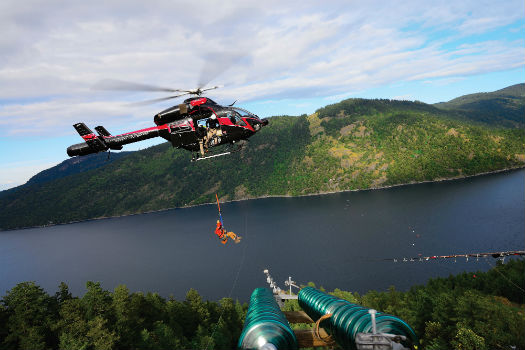
Ascent Helicopters conducts many of its hoisting operations with a Bell 212HP, but it also has a hoist-equipped MD 902. Greg Goodison Photo
One Tool Among Many
If HEC is an exceptionally valuable tool, however, it’s also not the only tool available to helicopter operators. Whether in a rescue or a work situation, responsible use of HEC requires recognizing when another method would be right for the job. For example, said Andrew Simpson, when the work site is a significant distance from the nearest suitable landing zone, B.C. Hydro would typically prefer hoisting, as personnel could ride inside the aircraft for the long transit. That’s one reason why Ascent Helicopters has been providing hoisting services to B.C. Hydro (and Finnair hasn’t ruled out acquiring a hoist in the future).
Meanwhile, on the other, much flatter side of the country, HEC remains less common, as there’s less compelling need for it. John Bosomworth, chief pilot of Ontario’s Hydro One, remarked, “I don’t see us at Hydro One doing human external cargo in the near future. It’s quite a process to do it safely.” Hydro One conducted hoisting operations for many years, but now it relies on its helicopter-mounted “Air Stair” to move linemen on and off transmission structures. Although Hydro One considered adopting HEC for rescue operations, it concluded that the need for such operations was too rare to be worth it. Said Bosomworth, “The risk of introducing human external cargo for the gain didn’t make sense.”

Hydro One does not expect to adopt HEC anytime soon. Instead, it uses its proprietary “Air Stair” to transfer linemen to transmission structures. Mike Reyno Photo
At the end of the day, the decision to use HEC demands exactly that type of analysis — a careful weighing of whether the benefits outweigh the risks. In some cases, they clearly do. In other cases, the balance is questionable.
“It’s something that’s not taken lightly,” concluded Finn. “We want to take it in very slow measured steps so we’re doing it safely.”
Bob Petite contributed to this report.





